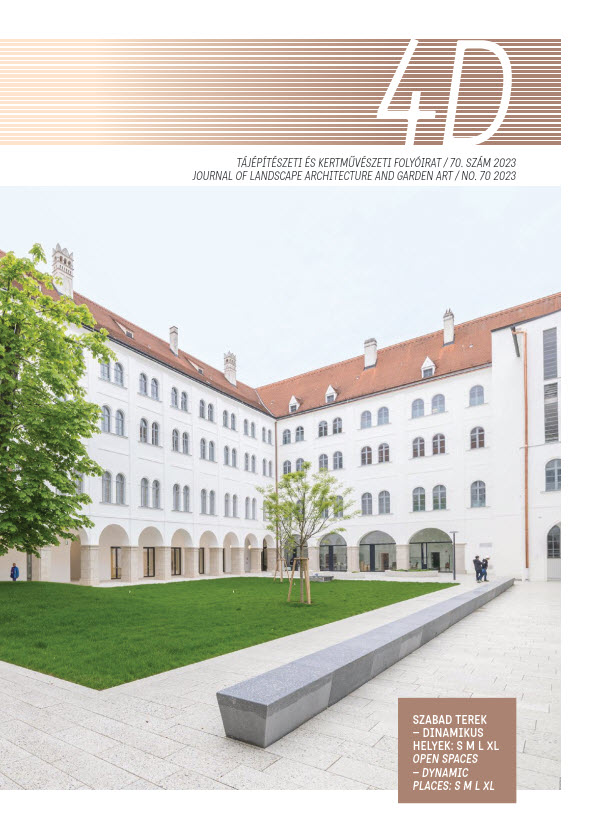The green spaces of the urban fabric shaped by succession
Defining urban wilderness based on case study analysis
DOI:
https://doi.org/10.36249/4d.70.4803Keywords:
urban wilderness, succession, mental well-being, environmental psychology, sustainability, green networkAbstract
The discipline of landscape architecture is witnessing a radical shift in approach. With the emergence of nature-based solutions in urban public space development, the extensive maintenance of green spaces has also come under the spotlight. The focus of this research is on the ways of establishing and expanding consciously created green spaces dominated by succession, also known as urban wilderness areas. The planning and management of these areas as a whole and of their components is still a complex task that raises many questions. In this article we define the concept of urban wilderness. In addition to the characterisation and interpretation of urban wilderness, we will also discuss its impact on the mental well-being of urban dwellers, i.e. its passive recreational aspects. The theoretical foundations explored are put into practice in a university workshop. The workshop, as an experimental laboratory, sought to answer the question of how theoretical research findings can be integrated into domestic, classical planning practice. As a result, four student concept designs were developed for a real site.
References
Fahrig, Lenore (2003): Effects of Habitat Fragmentation on Biodiversity, Annual Review of Ecology, Evolution, and Systematics [online], 34( pp. 487-515.), DOI: https://doi.org/10.1146/annurev.ecolsys.34.011802.1324194
Gobster, Paul H. (2011) Towards a natural history of unnatural places, in Jorgensen, A., Keenan, R.: Urban Wildscapes. Routledge, Oxon, United Kingdom, pp. 33-48. DOI: https://doi.org/10.4324/978020380754520
Harvey, Graham (1999) Living Landscapes.National Trust: Swindon, UK, p. 32.12 Lőhmus, Kertu - Liira, Jaan (2013): Old rural parks support higher biodiversity than forest remnants. Basic and Applied Ecology[online], 14(2), pp. 165-173. DOI: https://doi.org/10.1016/j.baae.2012.12.00913
Institute of Linguistics of the HungarianAcademy of Sciences (2016). [online] In. URL: https://mek.oszk.hu/adatbazis/magyar-nyelv-ertelmezo-szotara/[12.10.2023].8
Jorgensen, Anna - Hitchmough, James - Dun-nett, Nigel (2007): Woodland as a setting for housing-appreciation and fear and the contribution of residential satisfaction and place identity in Warrington New Town, UK. Landscape and Urban Planning [online], 79(3-4), pp. 273-287. DOI: https://doi.org/10.1016/j.landurbplan.2006.02.015
Konijnendijk, Cecil C. (2018) The Forest and the City. Springer International Publishing. Heidelberg, Germany. DOI: https://doi.org/10.1007/978-1-4020-8371-614
Li, Guangdong – Fang, Chuanglin – Li, Yingjie – Wang, Zhenbo – Sun, Siao – He, Sanwei – Qi, Wei – Bao, Chao – Ma, Haitao – Fan, Yupeng - Feng, Yuxue – Liu, Xiaoping (2022): Global impacts of future urban expansion on terrestrial vertebrate diversity Nature Communications[online], 13(1628), DOI: https://doi.org/10.1038/s41467-022-29324-23
Liu, Zhifeng - He, Chunyang - Wu, Jianguo (2016): The Relationship between Habitat Loss and Fragmentation during Urbaniza-tion: An Empirical Evaluation from 16 World Cities. PLOS-ONE [online], DOI: https://doi.org/10.1371/journal.pone.01546137
Lupp, Gerd (2015): Wilderness – Consequ-ences of a mental construct for landscapes, biodiversity and wilderness management. European journal of environmental sciences[online], 2(2), pp. 110-114. DOI: https://doi.org/10.14712/23361964.2015.3111
Min Lee, Cheol – Park, Jin Wook - Kwon, Tae-Sung – Kim, Sung-Soo – Ryu, Jae Won – Jung, Seung Jae - Lee, Sun Kyung (2015): Diversity and density of butterfly commu-nities in urban green areas: an analytical approach using GIS. Zoological Studies[online], 54(4), DOI: https://doi.org/10.1186/s40555-014-0090-75
Nassauer, Joan Iverson (1995) Messy Ecosystems, Orderly Frames. Landscape Journal. 14(2), University of Wisconsin Press, Wisconsin, USA, pp. 161-170. DOI: https://doi.org/10.3368/lj.14.2.16121
Piet Vosloo (2018): Post-industrial urban quarries as places of recreation and the new wilderness – a South African perspective Town and Regional Planning[online], DOI: https://doi.org/10.18820/2415-0495/trp72i1.410
Rutko, Ebony A. - Gillespie, Judy (2013) Where's the Wilderness in Wilderness Therapy? Journal of Experiential Education[online], 36 (3), pp.218-232. DOI: https://doi.org/10.1177/10538259134891079
Seto, Karen C. - Fragkias, Michail - Güne-ralp, Burak - Reilly, Michael K. (2011): A Meta-Analysis of Global Urban Land Expansion PLOS-ONE [online], DOI: https://doi.org/10.1371/journal.pone.00237776
Tuan, Yi-Fu (2001): Space and Place: The Perspective of Experience. University Of Minnesota Press, Minnesota, United States. pp. 3-7.16 Grahn, Patrik - Stigsdotter, Ulrika K. (2010): The relation between perceived sensory dimensions of urban green space and stress restoration Landscape and Urban Planning[online], 94(3-4), pp. 264-275. DOI: https://doi.org/10.1016/j.landurbplan.2009.10.01217
Twerd, Lucyna – Krzyżyński, Maciej - Waldon-Rudzionek, Barbara – Olszewski, Piotr (2017): Can soda ash dumping grounds provide replacement habitats for digger wasps (Hymenoptera, Apoidea, Sphecifor-mes)? PLOS-ONE [online], DOI: https://doi.org/10.1371/journal.pone.01756642
van den Berg, Agnes - ter Heijne, Marlien (2004): Angst voor natuur: een theoretische en empirische verkenning. Journal Land-schap : tijdschrift voor landschapsecologie en milieukunde. 21(3), Wageningen Universiteit en Research Centrum, Wageningen, The Netherlands, pp. 137-145.15
Ward Thompson, Catherine (2011) Places to be wild in nature, in Jorgensen, A. - Keenan, R.: Urban Wildscapes. Routledge, Oxon, UK, pp. 49-64. DOI: https://doi.org/10.4324/978020380754519
Williams, Kathryn - Harvey, David (2001): Transcendent Experience In Forest Environments Journal of Environmental Psychology [online], 21(3), pp. 249-260. DOI: https://doi.org/10.1006/jevp.2001.020418
Downloads
Published
Issue
Section
License
Copyright (c) 2023 Pap Miklós László, Bagdiné Fekete Orsolya, Balogh Péter István , Takácsné Zajacz Vera, Almási Balázs

This work is licensed under a Creative Commons Attribution-NonCommercial-NoDerivatives 4.0 International License.
A folyóirat Open Access (Gold). Cikkeire a Creative Commons 4.0 standard licenc alábbi típusa vonatkozik: CC-BY-NC-ND-4.0. Ennek értelmében a mű szabadon másolható, terjeszthető, bemutatható és előadható, azonban nem használható fel kereskedelmi célokra (NC), továbbá nem módosítható és nem készíthető belőle átdolgozás, származékos mű (ND). A licenc alapján a szerző vagy a jogosult által meghatározott módon fel kell tüntetni a szerző nevét és a szerzői mű címét (BY).






 intézetigazgató: Dr. Fekete Albert
intézetigazgató: Dr. Fekete Albert


